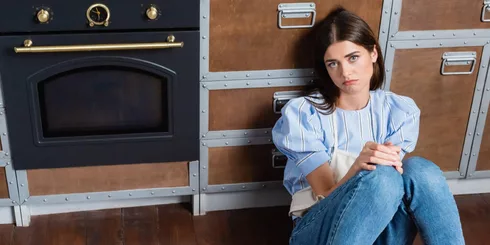I find working with air drying modelling clay very rewarding, it allows me to make almost anything from pots to magnets, but it does require me to be patient. Not only do us crafters put time into our creation, there is also the small matter of waiting for them to dry out and it can be tempting to start decorating after only a short amount of drying time.
You should not paint air dry clay before it dries as this can lead to cracks in your work, internal mould from trapped moisture and deformations of your item as the paint shrinks and pulls the clay out of shape.
After all the time and effort put into making wonderful items I’ve found it best to wait and ensure the item is fully dry before decorating. This also ensures there is no additional moisture on the surface of your project, if there is the paint may not stick correctly.
This is different to kiln fired clay which can be ready in less than 24 hours thanks to the firing process, one of the benefits of air-dried clays is that an expensive kiln isn’t required, but that comes with the price of a longer drying time.
How long does air dry clay take to dry?
Depending on the size of your piece, how thick it is, and the environment you’ve left it to dry in you can expect to wait at least 24 hours, but potentially up to 72 hours, for your item to fully dry.
Fortunately this means you don’t need to rush to store any unused clay, it doesn’t immediately set and you can have it out while you create your finished piece. However, it is important to pack away unused materials when you’ve finished, usually in an airtight container or bag, preventing wasting them with them setting.
I’ve found my clay sculptures are touch dry after 24 hours but I’ll usually leave them a few days to be 100% sure they’re fully dry.
The larger the item, the longer the drying time, but don’t go too thin in a quest for quick drying projects as this can lead to cracking during the drying process. I’ve read that a good rule of thumb is to allow 24 hours of drying time per centimetre.
I have a little tip someone once told me: Flip your item over part way through the drying process. Why? There could be moisture trapped between the base of your sculpture and the surface it is sat on, so where possible exposing the base allows it to dry out quicker and more evenly.
One thing to note, being water based means that until they are sealed and protected from moisture they can be softened again with a little water. This can be very useful if you’re looking to join to pieces to each other as you can simply add water to soften the area of the join before leaving it to dry out.
There are very good reasons for leaving your project to fully dry, for example if the surface you’re painting is damp the paint might not stick correctly. If the outside is dry but there is still moisture inside then the use of acrylic paint can seal the moisture inside, eventually your item could be damages by mould growing inside out.
I would also be concerned about damaging the look of my project. Think about how malleable air dry clay is before drying, if you’re painting with a brush it would be easy to accidentally deform your work by pressing too hard when applying paint.
What are the best paints for air dry clay?
Water based acrylic paints are best for air dry clay projects. They don’t provide a waterproof seal (this can be applied at a later stage) but do offer vibrant colors that don’t fade over time.
An alternative to acrylic paints is tempera paints, a thinner and more liquid paint than acrylic which dries matte.
Both are water-soluble, can be thinned and during the drying process can damage damp projects. The only way I can think to describe how this damage occurs is to ask you to pop a face mask on, one that starts damp and dries out.
As the mask dries you’ll feel your skin be pulled tighter as the mask shrinks a little, it’s this exact same process that can cause damage to damp clay, it gets pulled out of shape as the paint dries.
You can get a range of vivd colors and you might be tempted to start mixing with water, I wouldn’t do this as the introduction of additional water runs the risk of softening the clay which can result in cracks as it re-dries. It is fine to mix different paint colors together, just don’t add water.
I leave my painted item to dry for at least an hour, but often overnight to be sure it’s fully dry. I can then touch it up or apply a second coat if required.
My air dry clay isn’t quite ready to paint, shall I put it in the oven?
You shouldn’t put air dry clay in the oven as you risk it cracking from drying out too fast. They dry from the outside surface to the inside, if you speed this process up the outside could dry too quickly, because clay shrinks when drying if the outside shrinks faster than the inside then cracks can form or the item can become deformed.
Unlike regular clay air dry clay isn’t designed to be heated up to dry out, you’re just going to have to wait the 24-72 hours required for the natural drying process to take place.
As mentioned above, you can shave a little drying time off by exposing the base, ensuring moisture isn’t trapped.
I hope this blog post has been helpful, outlining why you shouldn’t paint air dry clay before it dries. Be patient, be creative, be awesome!












